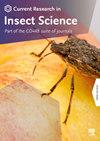The trypanosomatid (Kinetoplastida: Trypanosomatidae) parasites in bees: A review on their environmental circulation, impacts and implications
IF 2.7
Q1 ENTOMOLOGY
引用次数: 0
Abstract
Trypanosomatids, obligate parasites capable of impacting insects' hindgut, have recently obtained considerable attention, especially about their effects on bees. While Crithidia mellificae and C. bombi were initially discovered and studied in honey bees and bumblebees, respectively, molecular techniques revealed Lotmaria passim as the predominant trypanosomatid in honey bees globally. New species like C. expoeki and C. acanthocephali have also been identified. These parasites have complex life cycles involving various host developmental stages and are transmitted horizontally within and outside colonies through direct contact, oral interactions, and contaminating flowers with infected faeces. The impact of trypanosomatids on honey bee colony health remains uncertain. In bumblebees, studies highlighted the widespread presence of C. bombi, affecting colony and individual fitness, development, and foraging behaviour. Bee trypanosomatids have been detected in various species, including other insects, and mammals, suggesting diverse epidemiological pathways and potential effects that warrant further investigation. Biotic factors, including co-infections, gut microbiota, food contamination, and abiotic factors like environmental conditions, pesticides, and urbanization, play crucial roles in infection dynamics. This review aimed to summarise key research on trypanosomatid transmission and infection in both managed and wild bees, focusing on the influence of biotic and abiotic factors. The work highlights significant gaps in current knowledge and provides a valuable foundation for future studies. Understanding the pathogenicity and infection dynamics of trypanosomatids, along with the impact of environmental factors, is essential for developing effective conservation strategies that support pollinator health and overall ecosystem resilience.
蜜蜂体内锥虫虫科寄生虫的环境循环、影响及启示
锥虫是一种专性寄生虫,能够影响昆虫的后肠,最近得到了相当多的关注,特别是它们对蜜蜂的影响。虽然最初分别在蜜蜂和大黄蜂中发现和研究了Crithidia mellificae和C. bombi,但分子技术表明Lotmaria passim是全球蜜蜂的主要锥虫。新物种如C. expoeki和C. acanthocephali也被发现。这些寄生虫具有复杂的生命周期,涉及宿主的不同发育阶段,并通过直接接触、口腔相互作用和被感染的粪便污染花朵在菌落内外水平传播。锥虫病对蜂群健康的影响尚不清楚。在大黄蜂中,研究强调了C. bombi的广泛存在,影响了群体和个体的适应性、发育和觅食行为。蜜蜂锥虫病已在包括其他昆虫和哺乳动物在内的多种物种中发现,这表明存在多种流行病学途径和潜在影响,值得进一步调查。生物因素,包括合并感染、肠道微生物群、食品污染,以及环境条件、农药和城市化等非生物因素,在感染动态中起着至关重要的作用。本文综述了管理蜜蜂和野生蜜蜂中锥虫病传播和感染的重点研究,重点介绍了生物和非生物因素的影响。这项工作突出了当前知识的重大差距,并为未来的研究提供了宝贵的基础。了解锥虫的致病性和感染动态,以及环境因素的影响,对于制定有效的保护策略,支持传粉媒介的健康和整体生态系统的恢复能力至关重要。
本文章由计算机程序翻译,如有差异,请以英文原文为准。
求助全文
约1分钟内获得全文
求助全文
来源期刊

Current Research in Insect Science
Agricultural and Biological Sciences-Animal Science and Zoology
CiteScore
3.20
自引率
0.00%
发文量
22
审稿时长
36 days
 求助内容:
求助内容: 应助结果提醒方式:
应助结果提醒方式:


